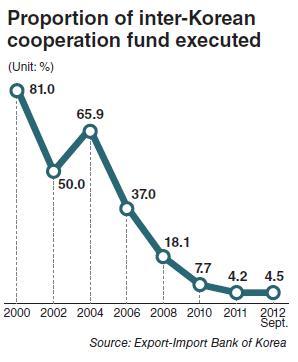Whither South-North economic cooperation?
Lawmakers submit bills to encourage inter-Korean businesses
By Korea HeraldPublished : Oct. 23, 2012 - 19:26

Relations between the two Koreas have been spiraling downwards over the past four years, with heightened tension and confrontation pushing out the wider economic cooperation considered an agent for peace.
With the Dec. 19 presidential election approaching in particular, the strain across the border is acute. The South Korean government is buttressing the security alertness over North Korea’s seeming attempt to sway the outcome.
Behind the tension, however, stands the pledge by the three main presidential candidates, all vowing to loosen the rigid inter-Korean relations with wider economic exchanges.
Rep. Park Geun-hye of the ruling Saenuri Party, Rep. Moon Jae-in of the main opposition Democratic United Party and independent Ahn Cheol-soo all agree on the need to promote and develop inter-Korean economic cooperation as the premise of establishing peace on the Korean Peninsula.
Some attentive lawmakers have been preparing some of the necessary tools, by submitting bills to establish special inter-Korean economic zones or to compensate for losses from worsened relations as a way to encourage better business participation.
Although these bills are yet to take the center stage at the National Assembly in light of the presidential showdown, they are expected to become the basis for a restart of inter-Korean exchanges.
For the time being, the status of inter-Korean exchanges remains bleak, especially since the Lee Myung-bak government’s May 24 measures in 2010 following North Korea’s attack on the warship Cheonan.

The inter-Korean trade amount between January and August this year reaches nearly $1.3 billion, a 15.2 percent increase from the same period a year before, according to the Korea Customs Service. Most of them, however, were the raw materials delivered to the Gaeseong industrial complex and the return of produced goods, meaning they do not represent the reality of the inter-Korean trade, or lack thereof. In other words, the rise in trade was not attributable to ordinary trade between the two Koreas, but to the existing output at Gaeseong.
The execution of the inter-Korean cooperation fund, designed to support exchanges among the two Koreas, is also expected to hit the bottom.
According to the report submitted to the Assembly by the Export-Import Bank of Korea this month, only 4.5 percent of the appropriated funds were doled out in the first nine months of this year. This is similar to the lowest level since 2000 ― the 4.2 percent recorded last year. Nearly half of the payments that were given out were also to resolve operational difficulties faced by companies in North Korea, not to start new transactions.
The Unification Ministry’s data, meanwhile, shows that the number of South Korean companies that entered Gaeseong has remained at slightly over 120, the same since the Cheonan crisis.
By Lee Joo-hee (jhl@heraldcorp.com)
-
Articles by Korea Herald


![[Weekender] 'Blood doesn't make family, love does'](http://res.heraldm.com/phpwas/restmb_idxmake.php?idx=644&simg=/content/image/2024/05/23/20240523050792_0.jpg&u=20240525160812)
![[KH Explains] US crackdown on Chinese connected vehicles unsettles Korea](http://res.heraldm.com/phpwas/restmb_idxmake.php?idx=644&simg=/content/image/2024/05/26/20240526050087_0.jpg&u=20240526163938)




![[AFRICA FORUM] Korea-Africa forum explores pathways to prosperity](http://res.heraldm.com/phpwas/restmb_idxmake.php?idx=644&simg=/content/image/2024/05/26/20240526050137_0.jpg&u=20240526174935)





![[AFRICA FORUM] Korea-Africa forum explores pathways to prosperity](http://res.heraldm.com/phpwas/restmb_idxmake.php?idx=652&simg=/content/image/2024/05/26/20240526050137_0.jpg&u=20240526174935)

![[AFRICA FORUM] Korea ready to be Africa’s partner in success: Vice FM](http://res.heraldm.com/phpwas/restmb_idxmake.php?idx=652&simg=/content/image/2024/05/26/20240526050125_0.jpg&u=20240526153144)

![[Herald Interview] SM subsidiary KMR aims to broaden K-pop spectrum](http://res.heraldm.com/phpwas/restmb_idxmake.php?idx=652&simg=/content/image/2024/05/26/20240526050203_0.jpg&u=)
